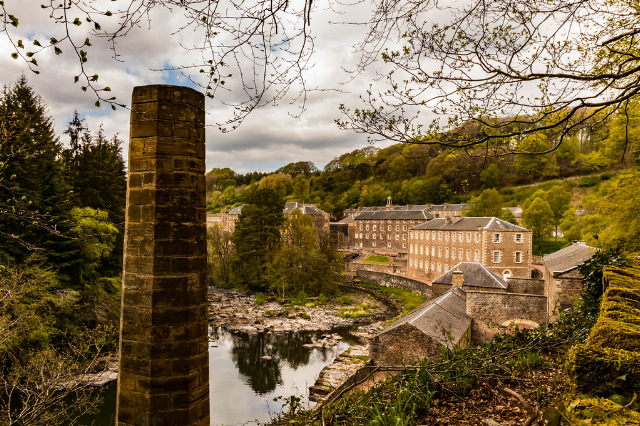Living with Climate Change
It’s really easy to think that the whole world is like home. I live in Central Florida, so warming seems like a threat. In the summer, it’s hot enough to threaten my ability to play golf, and it’s “hydrate or die.” Any warmer and I won’t be able to swear and beat the ground with sticks. Then this week I visited New Lanark, Scotland.
The woolen mill of this World Heritage Site is extremely proud of the fact that all its electricity comes from renewable sources that supposedly have small carbon footprints. It’s quite easy for them, since they are situated on a steep section of the River Clyde, allowing for ready development of hydro power. And Scotland is quite windy, with proliferating wind farms supply forty percent of all electricity in the country.
When I left the mill for my tour bus, I made certain that I was wearing a windproof three-layer outfit and a warm cap, since the temperature in late April was projected to reach a sultry high of fifty degrees. The wind chill wasn’t reported, but gloves were necessary if I was to be outdoors for long. The mill tour guide seemed to be caught flat-footed when I asked her if all this emphasis on “green” energy was designed to keep Scotland cold. Her startled laugh spoke volumes.
Most of the Karens of Klimate Katastrophe completely neglect the northern (or far southern) climes in their nattering. While various tropical and subtropical areas might have concerns with warmer temperatures, much of the civilized world is actually located in areas where an increase in average temperature might not have such awful effects as are routinely advertised. Florida’s upper crust, who can afford coastal vacation homes made possible by federal flood insurance, might find their property falling into the sea. Ditto for the California coastal elites. The rest of us won’t see much more than dramatic pictures at 6:30 and 11:00.
People in the upper Midwest will be thrilled as winter blizzards diminish. They may have a shorter ice fishing season, but will exchange that for longer growing seasons with fewer parka days. For those who don’t wish to board a giant aluminum cloud for  the trip across the pond to experience this, an alternative is readily available. Just get on a floating hotel and cruise the Inside Passage to Alaska. It’s a beautiful trip, and Juneau is the same degree of northern latitude as the Isle of Mull, where I am currently writing. Yesterday the snow level on Ben More was below three thousand feet.
the trip across the pond to experience this, an alternative is readily available. Just get on a floating hotel and cruise the Inside Passage to Alaska. It’s a beautiful trip, and Juneau is the same degree of northern latitude as the Isle of Mull, where I am currently writing. Yesterday the snow level on Ben More was below three thousand feet.
All this dramatic picture illustrates a simple fact: People adapt. If we don’t, we die. People who live in cold climes wear heavier clothing for thermal protection than Floridians. My golfing buddy’s SPF2 mesh tee shirt won’t be much use in Scotland, or Alaska, or Northern Canada. But if temperatures warm, those areas will be much more habitable. People will move northward (or southward down under). Such migrations are a fact of history. Eric the Red named the largest North Atlantic island “Greenland” simply because it was green, and a good place for farming. It didn’t stay that way because climate change froze it, just as it has done in multiple cycles since the second millennium BC.
Climate is always changing. Man has nothing to do with this simple fact. Our paltry contribution of carbon dioxide will raise the temperature of the earth by about the same amount that the period at the end of this sentence will block the light from your computer screen. It didn’t begin to rise much until long after warming began at the end of the Little Ice Age about two hundred years ago. If we achieve “net zero,” we may actually see a large part of the green on the earth disappear, since carbon dioxide is essential to all plant life. If, on the other hand, we encourage its rise, then plants will grow more readily in arid climates, allowing deserts to bloom like roses.
Space prevents a full discussion of the carbon footprints of “green” structures such as wind turbines, EVs, and other “environmentally conscious” items. In short, they are not green. All we have to do is to consider the fact that clouds, made of nothing but water, are at least a hundred times more potent modulators of climate. And the modeling of cloud dynamics is at present much of a black art.
The very idea that mankind can predict or control the climate is an ultimate act of hubris. The pursuit of climate modification is, rather, a religion, whose sole value inures to the person who declares what penance the rest of us must pay in order to pacify the demigods of green “virtue.” It is a fool’s errand, far more expensive to us in taxes and loss of freedom than any imagined benefit. We can and will adapt, regardless. My proper response to those who choose to be my “better” and command my behavior is not printable in this location. It is time for us to demand that they go away and leave us alone.
Ted Noel MD is a retired physician who podcasts and posts on social media as DoctorTed and @vidzette. He is a great-grandfather, pilot, golfer, and “Papa fix” who is conversant in many scientific, legal, and political disciplines. His greatest skill is critical thinking.
Image: Scotland by Camera





